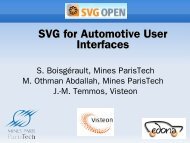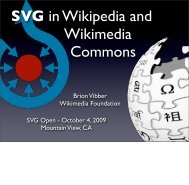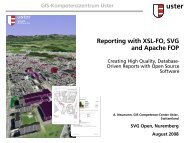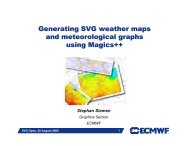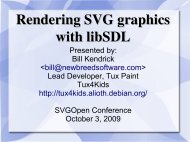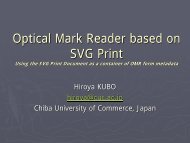Crowdsourcing Image Segmentation using SVG - SVG Open
Crowdsourcing Image Segmentation using SVG - SVG Open
Crowdsourcing Image Segmentation using SVG - SVG Open
Create successful ePaper yourself
Turn your PDF publications into a flip-book with our unique Google optimized e-Paper software.
<strong>Crowdsourcing</strong> <strong>Image</strong> <strong>Segmentation</strong> <strong>using</strong> <strong>SVG</strong><br />
Edward Kim and Xiaolei Huang<br />
October 17, 2011<br />
Department of Computer Science and Engineering,<br />
Lehigh University, Bethlehem, PA, USA
VERY BIG Problem<br />
� Understanding images for a machine
VERY BIG Problem<br />
� Understanding images for a machine
Motivate the Problem<br />
� Imagine you want to train a computer to recognize<br />
object<br />
� teach a computer what a bottle looks like, or what<br />
a tree looks like
Motivate the Problem<br />
� Imagine you want to train a computer to recognize<br />
object<br />
� teach a computer what a bottle looks like, or what<br />
a tree looks like<br />
� Step further, search for image or movie based upon<br />
content<br />
� images of me and my family next to Mickey Mouse
� Point & Speak<br />
BIG Problem
� Point & Speak<br />
BIG Problem<br />
� Build a large dataset of<br />
annotated images
Obtain a large database of annotate images<br />
� How do we get this dataset?
� Bad - “Me”<br />
Multiple ways to get the job done<br />
� 30 sec - 1 minute to annotate an<br />
object in an image<br />
� 1,000 image database could<br />
take up to 17 hours<br />
� 12 million images [deng2009],<br />
which could take a user 22.83<br />
years
� Bad - “Me”<br />
Multiple ways to get the job done<br />
� 30 sec - 1 minute to annotate an<br />
object in an image<br />
� 1,000 image database could<br />
take up to 17 hours<br />
� 12 million images [deng2009],<br />
which could take a user 22.83<br />
years<br />
� Good - “You”
� Bad - “Me”<br />
Multiple ways to get the job done<br />
� 30 sec - 1 minute to annotate an<br />
object in an image<br />
� 1,000 image database could<br />
take up to 17 hours<br />
� 12 million images [deng2009],<br />
which could take a user 22.83<br />
years<br />
� Good - “You”<br />
� Better - “Computer & You”<br />
� **Best - “Computer”
� Motivate the Problem<br />
� Introduction<br />
� Related Work<br />
Outline<br />
� Methodology & Framework<br />
� Segmenting objects in images<br />
� <strong>Crowdsourcing</strong> via Amazon Mechanical Turk<br />
� Experiments and Results<br />
� Conclusion and Past & Future Work
Related Work<br />
� [Yao 2007] - Lotus Hill Dataset<br />
� [Russell 2008] - LabelMe<br />
� Online annotation system<br />
� Also utilizes Mechanical Turk (just “you”)<br />
� Non-standard storage and visualization (XML)<br />
� Our system<br />
� uses standardization, visualization of XML <strong>using</strong> <strong>SVG</strong><br />
� Computer & You
Methodology & Framework<br />
� <strong>Segmentation</strong> Methods<br />
� Manual segmentation
Manual <strong>Segmentation</strong><br />
� to display a raster image<br />
� onclick events, draw s<br />
� clicking on first circle closes the annotation<br />
and appends a with the clicked<br />
points
Semi-Automatic <strong>Segmentation</strong><br />
� Use interactive computer segmentation methods to<br />
provide more accurate object segmentations
Semi-Automatic <strong>Image</strong> <strong>Segmentation</strong><br />
� We use active contours [Kass 1988]<br />
� Send “rough” polygon to the server via AJAX.<br />
� Active contours evolves the “rough” polygon towards<br />
the edges of the image.<br />
� Returns the <strong>SVG</strong> result
� create Human<br />
Intelligence Tasks<br />
(HITs)<br />
� Given instructions<br />
on how to<br />
annotate and what<br />
to annotate<br />
� provide a manual<br />
segmentation and<br />
present both<br />
manual and semiautomatic<br />
results<br />
Amazon Mechanical Turk
� Ask which result<br />
they prefer<br />
� store result in<br />
MySQL database<br />
� after completing<br />
the HIT, the<br />
worker is paid<br />
$0.05.<br />
Amazon Mechanical Turk
Results<br />
� 242 images from the ETHZ dataset which consists of 5<br />
classes
Results<br />
� Publish 5 HITs per image for a total of 1,210 HITs<br />
� Within 3 hours and 11 minutes, all 1,210 HITs were<br />
completed by 71 unique workers<br />
� Average time per HIT, 1 minute 39 seconds<br />
� Worker cost = $0.05 per hit = $60.50<br />
� Amazon Fees = $6.05<br />
� Total cost = $66.05
Results, “Computer & You”<br />
� In 93 out of 242 images at least one worker said that<br />
the semi-automatic segmentation result was better<br />
than their manual annotation
Visualization of results
Visualization of results
Results - Comments<br />
� 12 comments related to “nice”, “nice work”, or “good<br />
job”<br />
� “I am very lucky to work this job”<br />
� “your computer work not better then me”<br />
� “a cup has a topological gap, hard to handle”
Conclusion<br />
� We proposed a system for facilitating image<br />
annotation<br />
� Crowdsource the image segmentation task online<br />
<strong>using</strong> <strong>SVG</strong>
Additional Applications
Additional applications
� Questions?<br />
Thank you!



